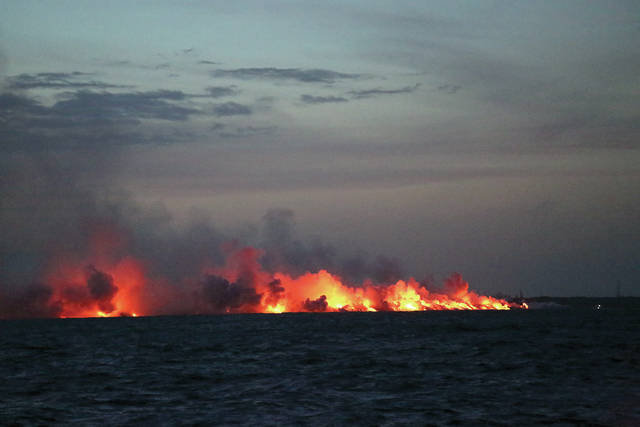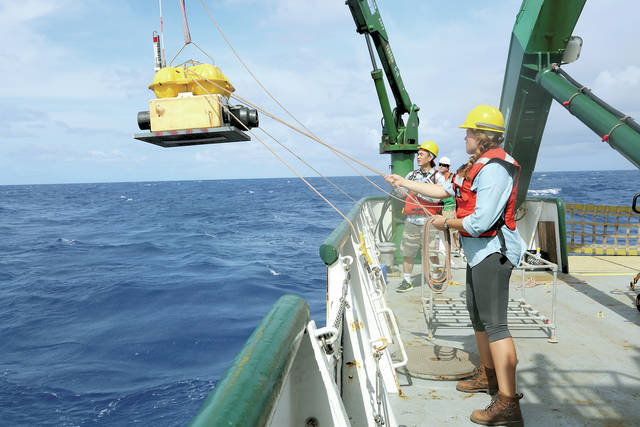The visible part of Kilauea from the summit to the Lower East Rift Zone makes up only a small portion of the total volcano. Much of Kilauea lies beneath the sea, including the Puna ridge to the east and the south flank extending offshore beyond the southern coastline.
As the volcano grows, this underwater region of the south flank creeps slowly to the south, moving in fits and starts with earthquakes that last seconds (such the May 4 magnitude-6.9 event) and in slow slip events, which last for days or weeks. Many questions have been raised about the stability of the south flank, since other portions of Hawaii Island’s coasts show evidence of past landslides.
Although Kilauea’s submarine south flank is a major part of the volcano, its motion is much harder to monitor than is the part above sea level. While we can record earthquakes occurring beneath the flank, only the largest, and those closest to shore, are well-captured by the USGS Hawaiian Volcano Observatory seismic network. In general, only a few offshore earthquakes are recorded. However, following the M6.9 earthquake and Kilauea’s LERZ eruption, a significant number of earthquakes took place beneath the south flank, some of which were in regions that have not typically been very seismically active.
To better understand what’s going on within Kilauea’s south flank and help determine how it has been affected by the eruption, a group of scientists from Western Washington University, Rice University and the University of Rhode Island deployed 12 ocean bottom seismometers in July on the submarine Kilauea south flank.
The instruments were deployed from the R/V Ka‘imikai-o-Kanaloa, a 223-foot research vessel operated by the University of Hawaii, during a weeklong cruise funded by the National Science Foundation.
Seismometers were positioned over the whole south flank so earthquakes associated with the edges of the flank could be recorded to see if the offshore stress field has changed. They also were positioned on the M6.9 aftershock zone to try to better understand that earthquake, and near the LERZ eruption ocean entry to study how lava enters the water and progresses downslope.
These data should allow the scientific team to determine more precisely where the offshore earthquakes occurred and on what fault(s) the M6.9 earthquake took place. Recordings of the ocean entry activity might help us learn more about why some lava-water interactions are explosive while others are relatively calm. In general, we hope that by collecting data offshore we will be able to better understand parts of Kilauea that cannot be easily observed.
The ocean bottom seismometers record data internally, so we won’t know what they recorded until they are recovered in September. A group of scientists on a related research cruise volunteered their time to collect our instruments and download the data for us. At that point, the data will be made available to any scientists interested in studying them, notably the seismologists at HVO.
While aboard the ship, we had a view of the eruption that was spectacular and sobering. The power and volume of lava flowing from fissure 8 to the sea was striking, even from miles offshore. We saw dozens of ocean entries over miles of coastline, and changes in the color of the seawater even miles offshore. But we also were witness to the pain of the eruption, watching black smoke as a structure burned, knowing it was yet another loss among many in the vibrant community.
Our thoughts continue to be with the people of Puna.
Volcano
activity updates
Activity on Kilauea’s Lower East Rift Zone and at the summit of the volcano remained greatly diminished this past week. LERZ activity was limited to a small crusted-over pond of lava deep within the fissure 8 cone and a few scattered streams of lava entering the ocean. Summit earthquakes remained at low levels.
The last summit collapse event occurred Aug. 2, and no significant subsidence has been observed since Aug. 4. However, hazardous conditions remain in both areas. Residents in the lower Puna and Kilauea summit areas should stay informed and heed Hawaii County Civil Defense closures, warnings and messages (http://www.hawaiicounty.gov/active-alerts).
HVO daily status reports are posted at https://volcanoes.usgs.gov/volcanoes/kilauea/status.html.
Two earthquakes with three or more felt reports occurred in Hawaii this past week: a magnitude-2.6 earthquake 13 km (8 mi) southeast of Volcano at -1.0 km (-0.6 mi) depth at 6:21 a.m. Aug. 11 and a magnitude-4.4 earthquake 15 km (9 mi) southwest of Leilani Estates at 8 km (5 mi) depth at 6:50 a.m. Aug. 9.
At Mauna Loa, HVO geophysical monitoring networks indicate that earthquakes and deformation are near background levels, and the USGS Volcano Alert level for the volcano remains at Normal. HVO continues to monitor the volcano closely and will report any significant changes.
Visit HVO’s website (https://volcanoes.usgs.gov/hvo) for past Volcano Watch articles, Kilauea daily eruption updates, Mauna Loa weekly updates, volcano photos, maps, recent earthquake info and more. Call for summary updates at 808-967-8862 (Kilauea) or 808-967-8866 (Mauna Loa). Email questions to askHVO@usgs.gov.









